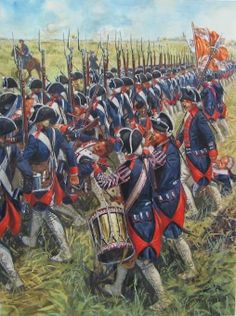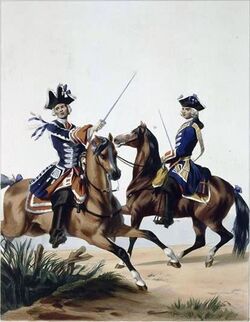Battle of Helderny: Difference between revisions
(→Battle) |
m (→Grythsheader) |
||
| Line 49: | Line 49: | ||
A detailed breakdown is as follows:<br> | A detailed breakdown is as follows:<br> | ||
Commander-in-Chief: Royal Secretary [[Sir Eustace Salter]] (k) | Commander-in-Chief: Royal Secretary [[Sir Eustace Salter]] (k) | ||
* '''Cavalry Corps''' - 3,300 troopers, 4 guns - General [[Sir Randall Fitton]] | * '''Cavalry Corps''' - 3,300 troopers, 4 guns - General [[Sir Randall Fitton]] (k) | ||
** '''Heavy Cavalry Brigade''' - 900 troopers - Colonel [[Andrew Able]] | ** '''Heavy Cavalry Brigade''' - 900 troopers - Colonel [[Andrew Able]] (w) | ||
** '''Royal Brigade of Dragoons''' - 1,400 troopers, 4 guns (6pdr) - Brigadier [[Geoffrey Crispe]] | ** '''Royal Brigade of Dragoons''' - 1,400 troopers, 4 guns (6pdr) - Brigadier [[Geoffrey Crispe]] | ||
** '''Light Cavalry''' - 1,000 troopers - Colonel [[Evelyn Whytton]] | ** '''Light Cavalry''' - 1,000 troopers - Colonel [[Evelyn Whytton]] (w) | ||
* '''Infantry Corps''' - 15,700 men | * '''Infantry Corps''' - 15,700 men | ||
| Line 58: | Line 58: | ||
** '''2nd Division''' - 3,900 men - General [[Osgood Stanley]] | ** '''2nd Division''' - 3,900 men - General [[Osgood Stanley]] | ||
** '''3rd Division''' - 4,400 men - General [[Arthur Callender, Viscount Lynchfield|Arthur, 3rd Viscount Lynchfield]] | ** '''3rd Division''' - 4,400 men - General [[Arthur Callender, Viscount Lynchfield|Arthur, 3rd Viscount Lynchfield]] | ||
** '''Light Division''' - 3,600 men - General [[Laurence Codrington]] | ** '''Light Division''' - 3,600 men - General [[Laurence Codrington]] (w) | ||
* '''Artillery''' - 24 guns | * '''Artillery''' - 24 guns | ||
Revision as of 22:32, 1 October 2021
| Battle of Helderny | |||||||
|---|---|---|---|---|---|---|---|
| Part of Riverlandian Conquest of Grythshead King Malcom's War | |||||||
| |||||||
| Belligerents | |||||||
|
|
| ||||||
| Commanders and leaders | |||||||
|
|
| ||||||
| Strength | |||||||
| 35,000 | 22,000 | ||||||
The Battle of Helderny was an engagement of King Malcom's War fought in 1750. A surprise victory for the outmatched Riverlanders of the Earl of Tarringway's army, it marked the opening of the campaign that came to be known as the Riverlandian Conquest of Grythshead. The Grythsheader army of Sir Eustace Salter, the King's secretary, was outmaneuvered and defeated in detail. Despite being outnumbered 3:2, the wide expectation that the Grythsheaders, battle-hardened and entrenched on their own soil, would win was confounded and the Riverlander victory paved the way to the eventual defeat and annexation of Grythshead.
Background
Following the intense campaigning season of 1749 in Harroway and Ballaeter, the armies of the South Vionna theatre of war settled down into winter quarters in the middle of November. Many left garrisons in the lands they had occupied and returned to friendly towns to wait out the cold season in comfort. A large portion of the Grythsheader Western Army, which had been engaged in Ballaeter for most of the war, fell back on the town of Helderny in north-east Grythshead to spend the winter there. Under the organisation of Sir Eustace Salter, who replaced the unwell General Byng as commander of that army, the Grythsheaders used the cold season as an opportunity to reinforce their depleted army and prepare for a grand offensive into Ballaeter when the campaigning season began again.
Spies brought this intelligence to the Earl of Tarringway, commander of the Riverlander Army of Ballaeter, who decided to capitalise on a mild winter to disrupt the Grythsheader plans to concentrate their forces. Despite receiving no reinforcement from his Ballaetan allies and conscious of his inexperienced troops, Tarringway determined to march on Helderny and engage Salter's main force before it could be bought up to strength. Though advised against this course of action by his staff, he could not be dissuaded and crossed the River Lochen with 35,000 men and 40 guns on New Years' Day, 1750.
Well-informed by a network of spotting towers and semaphore stations, Sir Eustace Salter was aware of the Riverlander movements by 3rd January. On the 4th, Salter took a tour of Helderny's defences with his chief engineer, Colonel Tadler. The pair agreed that the aging walls, though thick, could not stand up to a determined barrage and were also vulnerable to being taken by escalade. Therefore, that same day, Salter marched out with his full array (including 28 artillery pieces) and began hasty construction of defensive earthworks about half a mile to the north of the town. Breastworks, entrenched batteries and log barriers were built over the proceeding three days and work only stopped late in the evening on 7th January as, by then, the Riverlander forces were in close proximity and the Grythsheaders risked being caught unready.
Opposing Forces
Further Information: Helderny Order of Battle
Grythsheader
The Grythsheader army at Helderny was a force of twenty-two-thousand men with twenty-eight artillery pieces (mostly 12pdr or 8pdr cannon). This represented the main body of the force known informally as the Western Army, though it was not its full number. At full strength, the Western Army should have numbered over forty-thousand but its winter quarters were spread across the region and many reinforcements had yet to arrive. Sir Eustace Salter was the army's official commander, who had taken over from Sir Alexander Byng when the latter was struck by cholera. Salter was not an experienced military man but instead the King's secretary, a skilled organiser. He was attended by a staff of experienced officers who kept him well advised. Though he lamented the absence of his reinforcements, Salter had the strongest portion of the army available to him at Helderny including fresh guns, strong cavalry, and veteran infantry.
Salter's Grythsheader army was organised into four infantry divisions and three cavalry brigades. Of the infantry, the 1st Division (3,800) was led by Seyward Tillett, the 2nd Division (3,900) by Osgood Stanley, the 3rd Division (4,400) by Lord Lynchfield and the Light Division (3,600) by Laurence Codrington. The cavalry was led collectively by Sir Randall Fitton and individually by Andrew Able of the Heavy Cavalry Brigade (900), Geoffrey Crispe of the Royal Brigade of Dragoons (1,400) and Evelyn Whytton leading a brigade of light cavalry (1,000). This left Salter with 3,300 cavalry and 15,700 infantry, the remainder (roughly 3,000 men) were gunners, engineers, volunteers, or those employed on the staff or supply train.
A detailed breakdown is as follows:
Commander-in-Chief: Royal Secretary Sir Eustace Salter (k)
- Cavalry Corps - 3,300 troopers, 4 guns - General Sir Randall Fitton (k)
- Heavy Cavalry Brigade - 900 troopers - Colonel Andrew Able (w)
- Royal Brigade of Dragoons - 1,400 troopers, 4 guns (6pdr) - Brigadier Geoffrey Crispe
- Light Cavalry - 1,000 troopers - Colonel Evelyn Whytton (w)
- Infantry Corps - 15,700 men
- 1st Division - 3,800 men - General Seyward Tillett
- 2nd Division - 3,900 men - General Osgood Stanley
- 3rd Division - 4,400 men - General Arthur, 3rd Viscount Lynchfield
- Light Division - 3,600 men - General Laurence Codrington (w)
- Artillery - 24 guns
- 1st Battery - 6 guns (18pdr)
- 2nd Battery - 8 guns (12pdr)
- 3rd Battery - 8 guns (8pdr)
- 4th Battery - 4 guns (12pdr)
Riverlander
Outnumbering the Grythsheaders, the Riverlander Army of Ballaeter totalled thirty-five-thousand men with forty pieces of artillery. It came under the command of the Earl of Tarringway, a young general who had yet to see action during King Malcom's War. The Army of Ballaeter was a new army made mostly from fresh volunteers and most observers expected it, however strong in numbers, to wilt before the experienced veterans of the Grythsheader army. An advantage to the inexperience of this new army quickly became apparent, however: all of its kit and armament was fresh, mostly of recent manufacture if not taken from stocks, and a six-week training regimen had produced a force of men well-versed in drill and use of weaponry. The unit cohesion of the new regiments was high from collective training and discipline was excellent.
The Earl of Tarringway, who had lost two brothers in the war already, was evidently proud of his new command. He wrote to his wife on 21st December 1749, two days after having taken command: "Never before has such an impeccable force of fighting men been raised from our fields and cities." Most observers, however, took a more pessimistic view of the new troops. The visiting Count Roskoy wrote of the flamboyantly-dressed Riverlander heavy cavalry: "In forty years of war and struggle, I have never seen such a useless band of peacocks. Will all their finery turn away a cannonball?"
Seven infantry divisions made up a significant portion of the Army of Ballaeter and these were augmented by ad-hoc brigades formed from the grenadier and light companies which were detached from their parent battalions. Four brigades of cavalry came under the supervision of General Sarah Fitz-York and there were forty guns. The infantry divisions were Alexander Dunham's 1st (4,200), Harold Audley's 2nd (4,200), Sir Roger Parker's 3rd (3,600), Lady Euphemia Sparrow's 4th (3,600), Sewell Cotton's 5th (3,000), Sir Percival Kent's 6th (3,000), Lord Bedingfeld's 7th (3,600), and Nicholas Yden's 8th (3,600). Also the Grenadier Brigade (800) was led by Colonel Higden and the Light Brigade (800) by Baronetess Estone. The cavalry were the Brigade of Life Guards (700) commanded by Lord Chernocke, Dennis Beresford's 1st Cavalry Brigade (900), Robert Pen's 2nd Cavalry Brigade (750), and Benedict Culpeper's brigade of lancers (500). This created a total of 2,850 cavalry and 30,400 infantry.
Commander-in-Chief: General Lord Michael Fowler, 5th Earl of Tarringway
- Cavalry Corps - 2,850 troopers, 8 guns - General Sarah Fitz-York
- Brigade of Life Guards - 700 troopers - Colonel Lord Cornelius Chernocke, Marquess of Chernocke
- 1st Cavalry Brigade - 900 troopers, 4 guns (4pdr) - Colonel Dennis Beresford
- 2nd Cavalry Brigade - 750 troopers, 4 guns (4pdr) - Colonel Robert Pen
- Lancers - 500 troopers - Colonel Benedict Culpeper
- Infantry Corps - 30,400 men
- 1st Infantry Division - 4,200 men - General Alexander Dunham
- 2nd Infantry Division - 4,200 men - General Harold Audley
- 3rd Infantry Division - 3,600 men - General Sir Roger Parker
- 4th Infantry Division - 3,600 men - General Lady Euphemia Sparrow
- 5th Infantry Division - 3,000 men - General Sewell Cotton
- 6th Infantry Division - 3,000 men - General Sir Percival Kent
- 7th Infantry Division - 3,600 men - General Lord Archibald Bedingfeld, 4th Viscount Bedingfeld
- 8th Infantry Division - 3,600 men - General Nicholas Yden
- Grenadier Brigade - 800 men - Colonel Griffin Higden
- Light Brigade - 800 men - Major Beatrice Estone, 1st Baronetess
- Artillery - 32 guns
- 1st Field Battery - 8 guns (12pdr)
- 2nd Field Battery - 8 guns (12pdr)
- 1st Siege Battery - 6 guns (24pdr)
- 2nd Siege Battery - 6 guns (6pdr howtizer)
- Mortar Battery - 4 guns (12pdr mortars)
Battle
Deployments
The day opened with a furious bombardment. Under the cover of the cavalry brigades of Colonels Beresford and Pen, and the Light Brigade under Major Estone, the 12pdr and 24pdr guns of the Riverlander artillery deployed atop a low ridge across from the Grythsheader positions. The cannonade which opened the battle began at 10:30 and pounded the positions of the Grythsheader army with round shot while the Riverlander infantry deployed. The Earl of Tarringway kept a significant portion of his infantry - the 6th, 7th and 8th divisions - in reserve, hidden behind the ridge. Between that ridge, known as the Great Head, and the Grythsheader positions, was mostly farmland cut with fences, low stone walls, drainage ditches, and dirt roads. The distance was about a mile.

